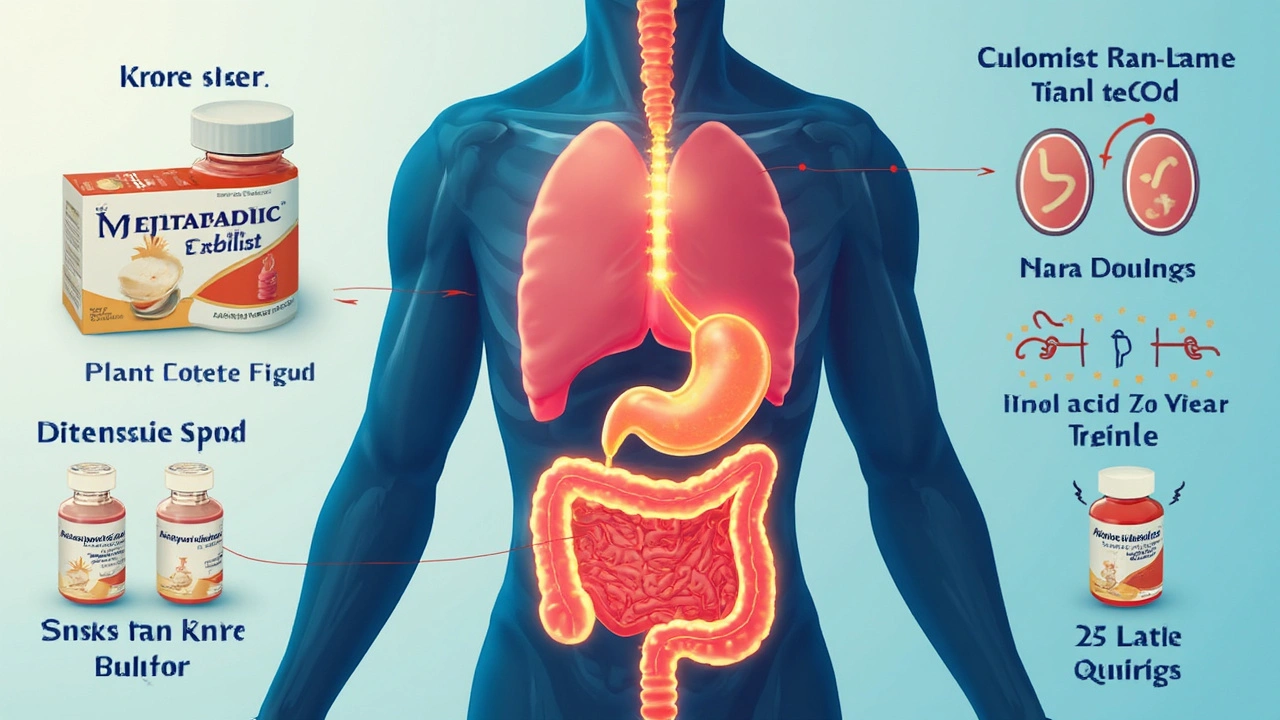Ever pop a mefenamic acid tablet for a killer headache or period cramps and wonder what magic is actually happening inside you? You’re not just masking pain—the medicine gets down to real work in your body.
This isn't some random chemical guesswork. Scientists mapped out exactly how mefenamic acid targets pain at its root. It’s made to block signals causing you discomfort, especially when pain and swelling gang up together. So, if you’re the type who wants relief with a side of science, it's the perfect painkiller to know about.
But hold up—using it right matters. Some folks take it like candy and later regret it with stomach aches or other issues. If you know how it actually works and what to watch for, you'll be way ahead next time life deals you more pain than you asked for.
- Pain: Why Does It Hurt?
- How Mefenamic Acid Works Inside You
- What Makes Mefenamic Acid Different From Other Painkillers?
- Tips for Using Mefenamic Acid Safely
- Debunking Myths and Sharing Fun Facts
Pain: Why Does It Hurt?
Pain may seem like some annoying alarm going off for no reason, but there’s actually a solid system behind it. Your body has nerves all over that act like warning sensors. When something’s wrong—say, you cut your finger, bash your knee, or get cramps—these nerves send a signal straight to your brain that shouts, "Hey, something’s up!"
This whole pain process is super important. Without it, you wouldn’t pull your hand off a hot stove or stop playing basketball after twisting your ankle. Pain relief medicines like mefenamic acid step in when this warning system is on overdrive or starts flipping out for smaller stuff, like migraines or period cramps.
So, what actually sparks these pain signals? The body releases chemicals called prostaglandins when you get hurt or have inflammation. Think of prostaglandins as the messengers spreading the word that something hurts and causing swelling or redness. That’s why inflamed tissues (like from a sprained ankle or bad headache) can feel much worse.
- Your nerves sense damage or irritation.
- They send a signal to your brain.
- Prostaglandins amp up the pain and swelling.
- Your brain decides how much it hurts and reacts.
Fun fact: not all pain is the same. Sharp, stabbing pain is often from real damage, while dull, aching pain is usually more about inflammation and those prostaglandins getting out of hand. That’s where mefenamic acid aims its effects—breaking the pain-inflammation cycle and giving your body a break.
How Mefenamic Acid Works Inside You
Mefenamic acid isn’t working on wishful thinking—it’s pure science at play. After you swallow a mefenamic acid tablet, your body absorbs it through your gut and shoots it into your bloodstream. Once it’s in your blood, it makes a beeline for the places where you’ve got pain or swelling.
Here’s where it gets clever. Most pain and swelling (think headaches, period cramps, or even muscle pains) happen because your body makes these little chemicals called prostaglandins. They run around your body causing pain and inflammation whenever there’s an injury or stress. Mefenamic acid is part of the NSAIDs group, so its main job is to block an enzyme called COX (short for cyclooxygenase). COX is like the chef in the kitchen making prostaglandins. If you stop the chef, you cut down on all those pain-causing dishes.
So the process goes like this:
- You take mefenamic acid.
- It blocks the COX enzyme.
- Your body makes less prostaglandins.
- You feel less pain and your swelling drops.
You might be surprised to know: mefenamic acid works both in your brain and your tissues. That’s why it can help with tough aches like menstrual pain, which come from muscle contractions and nerve signals.
Here’s a quick look at how long it sticks around in your system:
| Action | Time |
|---|---|
| Absorbed after taking | Within 2 hours |
| Pain relief starts | As quick as 1 hour |
| Stays active in body | About 4–6 hours |
Remember, just because it works doesn’t mean you should overdo it. If you use more than what’s prescribed, side effects can show up fast. Stick to your doctor’s advice for safe, steady relief.

What Makes Mefenamic Acid Different From Other Painkillers?
Sure, there are loads of painkillers out there—think ibuprofen, paracetamol, and aspirin. But what sets mefenamic acid apart isn’t just its name. It’s part of the NSAIDs (non-steroidal anti-inflammatory drugs) squad, but it’s got some unique moves, especially when it comes to tackling inflammation and certain kinds of pain.
The secret sauce? Mefenamic acid is known to work especially well for period pain, or as your doctor might call it: menstrual cramps. It’s more targeted in this area than many other NSAIDs. While you could take ibuprofen or naproxen for cramps, mefenamic acid often gets the nod for its double whammy of calming inflammation and relaxing the uterus.
If you’re curious about how it stacks up, check this out:
| Drug | Main Use | Affects Prostaglandins? | Common for Period Pain? |
|---|---|---|---|
| Mefenamic acid | Period pain, headaches, muscle aches | Yes (strong effect) | Yes (often preferred) |
| Ibuprofen | Fever, general pain, inflammation | Yes | Sometimes |
| Paracetamol | Headaches, general pain | Not as much | Rarely |
Another big difference is how your body breaks it down. Mefenamic acid goes through your liver, which is why people with liver issues need to steer clear or use it only under a doctor’s watch. Meanwhile, some other painkillers aren’t as harsh in this department. It also tends to be kinder to the stomach than older NSAIDs like aspirin—but not risk-free.
One more tip: mefenamic acid usually works fast, often within an hour for period cramps. Some studies have shown it can reduce bleeding in heavy periods, which most over-the-counter painkillers just can’t match.
Bottom line? When period pain hits hard, or if you're dealing with inflammation-driven aches, mefenamic acid brings features other painkillers just don’t. But just because it’s strong and specific doesn’t mean you should use it without checking if it's right for you.
Tips for Using Mefenamic Acid Safely
If you’re reaching for mefenamic acid when pain strikes, you want it to help—not cause trouble. So here’s how you can use it smartly and avoid common mistakes.
First off, always follow the dose your doctor or the label gives you. Don’t double-up thinking you’ll get faster relief—it just ups the risk for stomach pain, ulcers, or even kidney stress. For most adults, the typical dose is 500mg to start, then 250mg every 6 hours if needed. Never take it more than 7 days unless your doctor says so.
- Take mefenamic acid with food or a full glass of water. This helps your stomach handle it better.
- Avoid mixing it with other NSAIDs like ibuprofen or aspirin. Combo use can mean more side effects.
- If you have a history of ulcers, kidney, or liver issues, check with your doctor first. This stuff isn’t for everyone.
- No alcohol while you’re on it. Mixing can worsen stomach problems.
- Watch for rare but real reactions: trouble breathing, swelling, rash, or black stools. If any show up, stop and call your doctor immediately.
Here’s a handy rundown in numbers:
| Side Effect | How Common? |
|---|---|
| Stomach pain/indigestion | 5-10% |
| Dizziness | Up to 7% |
| Allergic reaction | Less than 1% |
Dr. Anita Kaur, a clinical pharmacologist, sums it up:
“While mefenamic acid is effective for pain, patients need to respect its power. Even over-the-counter meds can cause trouble if misused.”
If you need it often—say, every period, every month—bring it up with your doctor. Maybe there’s something else going on, or a better option for long-term comfort.

Debunking Myths and Sharing Fun Facts
No, mefenamic acid isn’t just a stronger version of regular ibuprofen. This painkiller is unique in the way it zeroes in on period pain and inflammation, making it the go-to for some specific aches—especially period cramps, toothaches, or mild arthritis. It takes a different path in your body compared to other NSAIDs, so results and side effects can be a little different, too.
One popular myth says you can take mefenamic acid every time pain pops up. Not true. Doctors actually recommend using it for short bursts—like the first few days of a heavy period—not for long-term daily pain. Stick to the plan your doctor gives you, or you could risk stomach trouble or even kidney issues.
Worried you’ll build up a tolerance? No need. Research shows your body doesn’t get so used to mefenamic acid that it suddenly stops working, at least not if you use it as directed and not every day for weeks on end.
Ever wonder about how quickly it kicks in? On average, mefenamic acid starts working within one to three hours after you pop a pill. Here’s a quick look at some numbers about its use in pain relief, compared with other common NSAIDs:
| NSAID | Most Common Use | Typical Onset of Relief | Known for Treating |
|---|---|---|---|
| Mefenamic acid | Period pain, mild to moderate pain | 1-3 hours | Menstrual cramps, headaches |
| Ibuprofen | General mild pain, fever | 30-60 minutes | Headache, muscle aches |
| Naproxen | Longer-lasting pain | 1-2 hours | Arthritis, muscle pain |
Fun fact: Mefenamic acid was actually discovered back in the 1960s, and since then it's made its mark on the list of major NSAIDs. But even though it's widely used for period pain in certain parts of the world, you might not even find it in drugstores everywhere—some countries sell it by prescription only because of its potential side effects.
Here are a few quick tips and honest facts:
- Always take it with food to lower your risk of stomach irritation.
- Mixing it with alcohol? Not a good idea—it can cause even more stomach issues.
- Don’t swap mefenamic acid for another NSAID without talking to your doctor. Each painkiller has its own perks and downsides.
- Some folks are surprised that it’s not a ‘one-size-fits-all’ painkiller. It really shines for the type of pain tied to inflammation—think menstrual cramps over basic headaches.
So next time you reach for mefenamic acid, you’ve got the facts—and a few myths busted—to help you use it smarter.


12 Comments
Namit Kumar
July 18, 2025 AT 07:03Honestly, I appreciate articles like this that cut through the fluff and get down to the facts. Mefenamic acid has been around for a while but not many people really know why it works the way it does. It's fascinating how it targets prostaglandins to reduce inflammation and pain.
Personally, I've seen it recommended often over other NSAIDs in India, especially for menstrual cramps where options can be limited. But I do wonder about the potential risks with long-term use and if doctors here discuss the side effects enough.
Anyway, solid read, and the chemistry explanation made it less of a black box for me. More awareness on these meds can surely help people use them more responsibly. :)
Marsha Saminathan
July 18, 2025 AT 17:36Oh my gosh! This was SUCH a fascinating dive into mefenamic acid — I love learning about how these painkillers actually do their magic, even if they sometimes just seem like random pills we pop.
Honestly, I always thought all pain meds were the same until reading this — the way it stops those pesky prostaglandins and how your body processes it afterwards was super illuminating.
Also, the real-life tips on safe usage really hit home. It’s soooooo important we don’t just blindly take meds but understand them holistically — the vibrant dance of chemistry and biology inside us is just mesmerizing!
You gotta share more about these hidden stories behind everyday meds. Seriously, my curiosity’s been totally lit up by this article!
Taryn Thompson
July 19, 2025 AT 06:56Thank you for such an insightful post! As someone in healthcare, I often see confusion about NSAIDs like mefenamic acid and their appropriate use.
This article nicely outlines how the drug selectively inhibits cyclooxygenase enzymes, thereby decreasing prostaglandin synthesis. This is key to understanding both its efficacy and potential gastrointestinal side effects.
For those considering mefenamic acid, it’s essential to take it exactly as directed, avoid prolonged use, and consult your physician if you have any pre-existing conditions. Also, caution in patients with renal impairment or bleeding disorders is advised.
Overall, a well-rounded briefing that I will recommend to my patients for better comprehension.
Alice Settineri
July 19, 2025 AT 09:26Well, well, well, isn't this juicy? Mefenamic acid fighting those pain demons like a pharmaceutical superhero! 🦸♀️ I mean, who would've thought that a tiny pill could stealthily sneak into our systems and sabotage the molecules that cause us grief?
Y'all, the chemistry behind it all feels like some magical potion brewing inside us. I do wonder though, how many people actually pause and think about what their meds are doing after swallowing them?
Also, I gotta say this — the tips on what to watch out for are super important because sometimes people just overdose on painkillers like candy, totally oblivious to the ticking time bomb they're carrying.
Seriously, articles like these empower us to be smarter patients and not just blindly pop pills. More power to science and those keeping us informed!
Marsha Saminathan
July 19, 2025 AT 14:26@Alice Settineri Girl, you nailed it!!! It truly is like a superhero sneaking in to knock out those nasty chemicals causing our aches. I wonder though, how many of us REALLY understand what goes down inside our bods when we take these, right?
It’s the kind of behind-the-scenes action that feels like a secret recipe — all those enzymes and reactions making sure we get relief without the drama.
But yo, those watch-outs you mentioned? SO crucial. I can’t even count the number of people who just wing it with pain meds and then wonder why things spiraled!
Wish more peeps took a moment to actually respect the power of these meds… or the responsibility.
Sam Rail
July 19, 2025 AT 20:33Honestly, I skimmed this at first thinking, 'Cool, another science explanation,' but it actually gave me more respect for mefenamic acid. Never really understood why some docs pick it over others for period pain.
Though, I gotta say, some parts felt a bit dense. Would’ve loved more practical takeaway stuff like alternative options or stuff to avoid specifically with this drug.
That said, the chemistry clear-up is nice for the nerds out there like me. Still, definitely helps to understand what’s happening instead of just swallowing pills blindly.
Anyone experienced weird side effects or super benefits with this one?
nathaniel stewart
July 25, 2025 AT 02:56Glad to see such a thorough analysis of mefenamic acid’s mechanisms here! Sometimes with medical topics, I do stumble over technical jargon but this was fairly straightforward which I appreciate immensely.
Though I did notice a couple of typos scattered in the later sections, probably oversight. Aside from that, the balance between chemistry and practical usage tips was perfect.
In my experience, understanding the drug helps me feel more positive and in control about using it responsibly rather than fearful of unknown effects.
Looking forward to more scientific yet user-friendly breakdowns like this.
Pathan Jahidkhan
August 1, 2025 AT 00:13This piece kinda makes me think about pain itself, not just the medicine that kills it. Pain isn’t just a physical thing, it’s a cosmic reminder of our fragile mortality, eh?
Mefenamic acid interferes in this ancient dance by tampering with prostaglandins, the very messengers of distress. And yet, in suppressing pain, are we suppressing a part of our humanity? Food for thought.
That said, the article’s methodical approach to explaining this chemical interference is appreciated — it bridges the gap between the mysticism of pain and the cold calculus of science.
Still, I remain contemplative about where the balance lies between relief and reliance.
Dustin Hardage
August 7, 2025 AT 22:53As someone who often delves into pharmacological literature, I commend the clarity in explaining mefenamic acid's action on cyclooxygenase pathways.
It’s a vital reminder that this NSAID’s efficacy is not without potential complications, particularly gastrointestinal irritation and renal concerns, which laypersons often overlook.
Patient education on these points is critical to balancing pain management benefits with safety risks.
It would be interesting to see comparative analyses with other NSAIDs to contextualize mefenamic acid’s position in therapeutic regimens.
Such discussions can empower both physicians and patients to make better-informed choices.
Dawson Turcott
August 12, 2025 AT 14:00So, mefenamic acid literally stops pain by
Alex Jhonson
August 16, 2025 AT 01:20I appreciate the detailed overview, especially how it highlights the biochemical actions which many overlook when taking painkillers.
Interestingly, the article’s mention of dosing guidelines and watch-outs is crucial — misuse can often lead to unintended consequences.
I encourage everyone to view this as a starting point for discussions with medical professionals rather than definitive advice.
It’s also worth considering cultural differences in drug accessibility and usage norms, which affect outcomes worldwide.
Dana Sellers
August 17, 2025 AT 05:06Honestly, the world would be a better place if people stopped abusing painkillers, even ones like mefenamic acid that promise relief.
This article makes it clear that while these meds work wonders, they aren't magic pills — they come with risks and need respect.
Too often, folks pop pills without giving a second thought to their interactions or long term effects, which is just reckless.
If everyone read posts like this and took the advice seriously, maybe we'd see fewer emergency room stories and health messes.
Stay smart, respect your body, and don't treat meds like candy.